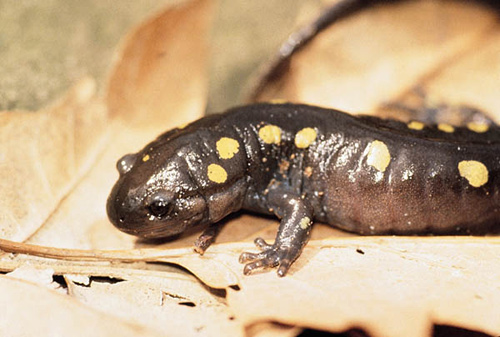The spotted salamander is a member of the mole salamander family, so named because the members of this family spend most of their lives underground. Spotted salamanders are smooth-skinned and black or dark gray with yellow spots. They have a gray belly. They can be up to 6-9 inches long and are the largest terrestial salamander in Connecticut.
The spotted salamander can interbreed with blue-spotted salamanders.
The range of spotted salamanders is through the eastern portion of the US except for Florida, and into southeastern Canada from south central Ontario to Nova Scotia. Spotted salamanders are Connecticut's most widespread mole salamander but the population is believed to be declining as a result of habitat loss and loss of vernal pools used for breeding. The population is vulnerable to these losses, but as of yet the species has no legal status in Connecticut.
Adult spotted salamanders spend most of their lives in burrows under leaf litter, rotting logs or rocks in woodlands. They hibernate over the winter in burrows or tunnels. They are nocturnal.
Mating season occurs in late March or April. Males and females emerge from their burrows and head to water to mate. Spotted salamanders are dependent on temporary vernal pools for mating which are safer for eggs and young as they are fish-free. They will not breed anywhere else.
The time of breeding for spotted salamanders is called "Big Night" by many herpetologists. On the first or second continuous night of rain in March or April when the night temperatures reach 45 to 50 degrees F, the adult spotted salamanders emerge from their hibernation burrows and migrate to the nearest vernal pool. The pools may still be icy and can be several hundred yards away. Generations of spotted salamanders will use the same pool every year. Although the mating period can go on for 2 weeks or so, most of the adults all head out on the first night.
During breeding, males come out of hibernation burrows ahead of the females by several hours and arrive first at the pools. There they form large balls of writhing males called congresses. As females arrive, individual males will separate from the congress and perform a courtship dance with a female. They will circle and put their heads under one another's tails. The male may climb on the female's back and rub her with his chin. The male will then swim away wiggling his tail. If agreeable, the female will follow. He leads her to a sperm packet he deposited earlier on submerged leaves on the pool's bottom. Females pick up these packets through their cloaca, the opening amphibians use for breeding, egg-laying and waste. Fertilization of her eggs takes place internally. One female may collect packets from several males.
The female will lay egg clusters of 100 to 250 eggs on submerged vegetation in the pool. Initially the gelatinous mass is clear but it becomes cloudy. This is believed to help protect the embryos from UV radiation. An algae that is unique to amphibian eggs may also grow in the egg clusters. They hatch into larvae in about a month.
The larval stage for these salamanders is aquatic and the larvae have gills. They live in the water while they develop into adults and have usually metamorphosized into the adult stage in about 4 months. They then leave the water and begin their terrestial life of burrowing.
Adult spotted salamanders eat insects and invertebrates. Their diet includes smaller salamanders. The larvae eat aquatic invertebrates and insects and consume many mosquito larvae.
A threatened spotted salamander can produce a sticky skin secretion.
